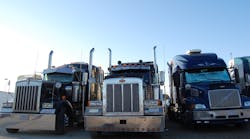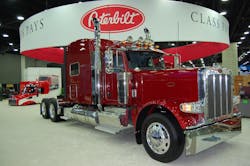A continued focus on fuel economy, more emphasis on “value” and lower total cost of ownership or “TCO” calculations, growth of vertically integrated and automated powertrains, plus changes to trailer designs are just some of the major trends industry experts believe will reshape the trucking equipment market near term.
In an interview with Fleet Owner, Pavan Pattada, newly-installed president of the North American Truck division for Eaton Corp., added that replacement demand will also remain strong as fleets continue to focus on improving fuel economy.“There remains an increased focus on fuel efficiency regardless of the [low] diesel fuel prices of late,” he said. “All fleets remain very keenly focused on that.”
With that demand for greater fuel economy gets combined with the ongoing shortage of truck drivers, it should also result in more movement to automated and automatic transmissions, as well, Pattada (seen at right) thinks.
“The trend towards downsizing of engines to save on weight and fuel means more shifting is required,” he explained. “So there is a risk entailed in maintaining fuel economy with new drivers not so skilled with manual transmissions. Automated products take that risk off the table.”
Michael Baudendistel, VP of Wall Street investment firm Stifel Nicolaus & Co. transportation & logistics research group, added in a statement that the topic of fuel efficiency of diesel-fueled equipment was the biggest theme at the Mid-America Trucking Show for the last two years.
Yet he believes that due to the recent decline in diesel prices, that “focus” should shift more broadly to TCO calculations as those encompass fuel efficiency as well as maintenance and opportunity costs associated with having equipment out of service.
Baudendistel also thinks the while vertical integration efforts of truck OEMs will remain a hot topic on the heavy-duty side of the market, “medium duty is where we may see a bigger shift in near-term market share.”
For example, Daimler Trucks North America plans to roll out its DD5 and DD8 medium-duty engines in the North American market starting in 2016, with plans to begin manufacturing those engines in North America starting in 2018.Back on the heavy-duty side of the market, Baudendistel believes Class 8 orders won’t be as strong in 2015 as they were in 2014. However, he thinks they will “settle” into a more “reasonable” level – roughly in line with recent industry production rates of about 25,000 units per month.
Truck OEMs themselves are also projecting strong truck sales for 2015 as well. Paccar Corp. – which owns Kenworth Truck Co. and Peterbilt Motors Co. – believes Class 8 retail sales in the U.S. and Canada will range between 250,000 and 280,000 units this year.
“Class 8 retail sales were 250,000 units in 2014, compared to the 212,000 vehicles sold in 2013,” noted Dan Sobic, Paccar’s executive VP back in January. “Truck demand is being driven by the improving economy and fleet expansion.”
ACT Research Co. data also indicates that while average age of the “active” Class 8 tractor fleet remains slightly elevated, it’s slowly falling due higher new unit sales over the last several years. From a peak of 6.7 years back in 2011, Class 8 tractor age fell to an average of 6.2 years in 2014, with ACT projecting that average to settle around six years between now and 2016 or so.
Another factor expected to support strong Class 8 sales this is year is the ability to extract more “value” from them, especially in terms of using vehicle data to drive cost savings, noted Sandeep Kar, global director of research, automotive and transportation for global consulting firm Frost & Sullivan.“The ‘value’ to the fleet customer is going to be the ability to reduce vehicle downtime via telematics and ‘big data’ analysis,” Kar (seen at right) explained to Fleet Owner in an interview.
He estimates that long-haul carriers should be able to eventually save some $4,000 per truck per year via data analysis.
By extension, such analytics should also help OEMs, too, by reducing warranty claims and offer up opportunities to sell a variety of ancillary telematics-related services.
“This also means the focus is going to change from ‘truck efficiency’ to ‘freight efficiency’ as truck-derived data will help fleets reduce empty miles and other operating costs,” Kar pointed out.
In terms of sales volume, Frost & Sullivan is projected 512,000 medium- and heavy-duty trucks will be sold in North American (the U.S., Canada, and Mexico) this year. The firm also thinks U.S. gross domestic product [GDP] growth will reach 2.8% in 2015; enough economic expansion to keep demand for truck capacity high.
Stifel’s Baudendistel pointed to a few other trucking equipment trends fleets should keep in mind as 2015 progresses:
- Even with lower diesel prices, the operational savings associated with new equipment still appears to be significant enough to generate a payback period which is shorter than the average equipment;
- High used tractor prices are lowering the capital required to purchase new equipment;
- Few build slots remain in 2015 for dry van trailers and in the near future trailer makers will face significant impact from the 2017 and 2020 greenhouse gas (GHG) regulations being crafted by the Environmental Protection Agency (EPA), requiring them to use lighter weight materials and trailer designs that reduce total material usage to improve fuel economy;
- Truck transmission automation – either through automated manual transmissions (AMTs) for line-haul applications or fully automatic transmissions for urban applications – will continue to get attention as a method for making it easier to find, recruit and retain commercial drivers. Eaton recently noted that it projects that the manual transmission share in the heavy-duty market to drop from 60% in 2014 to 35% by 2018.






